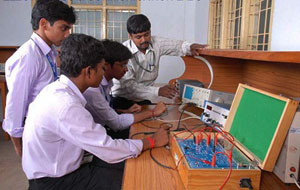Are you doing a valuable Project?
Sakshi Education
As a part of final semester it is very necessary to do a dissertation as a partial fulfillment for the award of degree. For scoring good percentage/grades in any degree, dissertation plays a very important role (some universities are awarding more than 200 marks for dissertation).


As a part of final semester it is very necessary to do a dissertation as a partial fulfillment for the award of degree. For scoring good percentage/grades in any degree, dissertation plays a very important role (some universities are awarding more than 200 marks for dissertation).
Selecting the topic:
For selection of any topic it is very essential to provide a clear description of the subject or thesis report which you want to convey to your advisor. Selecting a topic which is interesting and which is catchy to you will be a right choice. To gain success in your work and to get good grades, choosing a topic which you are interested in will be correct option to you. Your topic must be a subject having a large scope in it. The topic having no further scope makes the person disheartened. You must think a lot on topic which you are going to choose and must try doing your best in your work to get excellent results.
If any student have real thrust to do a innovative project in current technology, it is better to handle any one of the IEEE research paper in the domain of his interest. Initially it is difficult to understand an IEEE paper for an under graduate student. But once he understands and is capable to implement the method proposed in the paper, he can reach easily greater heights in future for higher studies.
CSE/IT
Important areas where CSE students can do their projects: Computer Networks, Data mining, Algorithms, Image processing, Natural Language processing, network security, biometrics, pattern recognition, machine learning, Expert systems etc.
Some Model Projects
Important Areas where ECE students can do their projects: Mobile Internet, Touch Screen, GPS, GSM Technologies, Wireless Technologies, Bluetooth Technologies, Robotics, Speech Recognition, Image Processing, Digit Signal Processing, RS405, Controller Area Network Protocol, Biometrics, VLSI
Some Model Projects
Important areas where EEE students can do the projects: Power systems, Power electronics, Microcontrollers, High voltage engineering, Fuzzy control systems, Power generation, Energy conservation, AC & DC Motors etc
Some Model Projects
MECHANICAL
Areas: Automation, Automobiles, Power & Energy, Robots, Material Handling, Alternate energy generation, Transportation, PC Based, CAD/CAM, CNC machines etc.
Some Model Projects
The organization of the report should be as follows
Selecting the topic:
For selection of any topic it is very essential to provide a clear description of the subject or thesis report which you want to convey to your advisor. Selecting a topic which is interesting and which is catchy to you will be a right choice. To gain success in your work and to get good grades, choosing a topic which you are interested in will be correct option to you. Your topic must be a subject having a large scope in it. The topic having no further scope makes the person disheartened. You must think a lot on topic which you are going to choose and must try doing your best in your work to get excellent results.
If any student have real thrust to do a innovative project in current technology, it is better to handle any one of the IEEE research paper in the domain of his interest. Initially it is difficult to understand an IEEE paper for an under graduate student. But once he understands and is capable to implement the method proposed in the paper, he can reach easily greater heights in future for higher studies.
CSE/IT
Important areas where CSE students can do their projects: Computer Networks, Data mining, Algorithms, Image processing, Natural Language processing, network security, biometrics, pattern recognition, machine learning, Expert systems etc.
Some Model Projects
- GSM based LAN monitoring system
- Simulating traffic congestion scenario
- Smart learning web
- Technical Education Manager
- Warehouse Management System
- Graphical Password Authentication using CCP
- Work to worker services to unorganized sector
- Budget Monitoring System
- Hacker approach to improve the AI behind CAPTCHA
- Mobile coupon plug-in for Software
- Content based image retrieval system
- Multi Biometric Fusion
- Authentication using fuzzy vault
- Routing algorithms for ADHOC mobile networks
- Web image mining based on UIQI
- A Distributed CSMA Algorithm for Throughput and Utility Maximization in Wireless Networks
- A Distributed Protocol to Serve Dyna-mic Groups for Peer-to-Peer Stream in
- Agent Based Efficient Anomaly Intrusion Detection System in Ad hoc network
- Anonymous Query Processing in Road Network
- Conditional Shortest Path Routing in Delay Tolerant Networks
- Congestion Control of Transmission Control Protocol Based on Bandwidth Estimation
- Cross-Layer Design in Multichip Wireless Networks
- Deactivation of Unwelcomed Deep Web Extraction Services through Random Injection
- Distributed Algorithms for Minimum Cost multicast With Network Coding Dynamic Multichannel Access With Imperfect Channel State Detection
- Engineering Wireless Mesh Networks Joint Scheduling, Routing, Power Control, and Rate Adapt
- Fast Algorithms for Resource Allocation in Wireless Cellular Networks
- Fault-tolerant Mobile Agent-based Monitoring Mechanism for Highly Dynamic Distributed Networks
- Implementation of Location-Aware M-Learning System
- Inference From Aging Information
Important Areas where ECE students can do their projects: Mobile Internet, Touch Screen, GPS, GSM Technologies, Wireless Technologies, Bluetooth Technologies, Robotics, Speech Recognition, Image Processing, Digit Signal Processing, RS405, Controller Area Network Protocol, Biometrics, VLSI
Some Model Projects
- Design & development of Touch Screen
- Design & development of MEMS based touch free Mobile
- Voice operated intelligent mobile phone with GPS
- Automatic Geo positioning and SMS alert on road traffic density
- Finger print based security access system
- Graphical LCD and memory stick based text book reading system
- Voice activated hospital bed control system
- Bluetooth based wireless home automation system
- Android smart phone intelligent home system
- Voice operated multipurpose robotic system
- Voice enabled devices switching for visually impaired
- Smart Wireless Temperature Data Logger (IEEE-2007)
- Mobile phone controlled four-legged walking robot with speed and direction control.
- GPS based universal clock. Gets the time from satellites and displays on GLCD.
- Microcontroller based online examination system with dynamic questions.
- Digital vehicle speedometer with password enabled speed limit setting.
- GPS based vehicle travel location-logging system. This System stores the traveler's geographical location and speed at an interval of one second and is stored in to 1GB MMC/SD memory card.
- SMS based remote SIM card's address book access system.
- Microcontroller based digital clock with Graphical LCD and Sanskrit font (or any regional font) Numbers.
- Microcontroller based virtual boundary/fencing for Wild Animals.
- GSM based instantaneous vehicle registration details extraction system very useful for Traffic police.
- Wireless Heartbeat Monitoring and Alert system.
- RFID/Mifare/Smart Card based security access control systems.
- GPS and GSM based real-time vehicle tracking on Google Earth (with two GSM Modems)
- Implementation of wireless sensors network for Wild Fire monitoring system.
- Real-time Heartbeat Monitoring system with display on Graphical LCD and Voice based alerting system.
- Touch screen operated liquid dispensing system.
- Infrared (IR) remote controlled Muscle Stimulator with duration and intensity control.
- GPS based border alert system for fishermen.
- MEMS Accelerometer based digital photo frame with automatic position/ view adjustment system (similar to digital cameras).
Important areas where EEE students can do the projects: Power systems, Power electronics, Microcontrollers, High voltage engineering, Fuzzy control systems, Power generation, Energy conservation, AC & DC Motors etc
Some Model Projects
- Controlling AC lamp Dimmer through Mobile Phone (IEEE-2010).
- Multiple Transformers oil temperature monitoring with automatic circuit breaker operation with SMS based alerts.
- A Novel Wireless Self-powered Microcontroller-based Monitoring Circuit for Photovoltaic Panels in Grid-connected Systems (IEEE-2010).
- Wireless Energy Meter reading on hand-help device based on RF Transceiver.
- SCADA implementation based on wireless RF technology. (IEEE-2009).
- Method of Measuring Power Quality and Development of Monitor Device (IEEE-2010).
- Motor speed monitoring and control system using GSM modem
- A Smart Card Based Prepaid Electricity System.
- High voltage fuse blown indicator with Voice based announcement system.
- Industrial/power grid electrical parameter Data Acquisition system through wireless technology.
- DC Motors speed synchronization for rolling mills.
- Touch Screen based digital devices control system. This project is to build a Graphical LCD Touch Screen interface for switching electrical devices. The controlled devices can be of high voltage or low voltage.
- Construction of central control unit for Irrigation water pumps. Cost effective method to control entire villagers' water pumps with user level authentication, Illiterates friendly system.
- Wireless Energy Meter monitoring sy-stem with automatic tariff calculation.
- Home Network Configuring Scheme for All Electric Appliances Using Zig Bee-based Integrated Remote Controller.
- Resistive Touch screen controlled contact less speed monitoring and controlling of dc motor with speed limit alerts.
- DC Motor Speed and direction control over GSM Mobile/Modem.
- Energy meter monitoring and control system using SMS technology (IEEE-2007).
- Energy meter data logging system with Real-time clock and KWH readings. Very useful for historical data logging and analysis.
- Energy meter per-day average, Max and Min Load display on Graphical LCD.
- MMC/SD card based data logger for energy meter with time and KWH readings for historical data logging and analysis.
- PIR based energy conservation system for corporate Computers and lighting system.
- Development of Zigbee based Street Light (IEEE-2008)
- Wireless power theft monitoring system and indication at local substations.
- Touch screen controlled lamp dimmer for next generation apartments.
- Wireless electrical devices monitoring and controlling system for industrial applications.
- Microcontroller and Touch screen controlled motor speed and direction controlling system.
- Touch screen operated industrial oil dispensing system (OIL SCADA).
- An On-line Monitoring System of Temperature of Conductors and Fittings Based on GSM SMS and Zigbee (IEEE-2008).
- 4-wired resistive touch screen controlled lamp dimmer for next generation apartments with Optical isolation and zero crossing detectors.
- High voltage fuse blown indicator with display on PC with optical isolation between PC and HV bus bars.
- An On-line Monitoring System of Transmission Line Conductor De-icing(IEEE-2008).
MECHANICAL
Areas: Automation, Automobiles, Power & Energy, Robots, Material Handling, Alternate energy generation, Transportation, PC Based, CAD/CAM, CNC machines etc.
Some Model Projects
- Air Cars
- Working model of Hovercraft
- Hydrogen (water) Powered vehicle
- Remote controlled material handling equipment (RCMHE)
- Remote controlled material handling robotic crane for Bomb squads
- Fire Fighting Robot
- Pneumatic paper cup forming machine
- Solar Powered Air Conditioner
- Over speed indicator and Accident Avoidance systems in a four wheeler
- Wall Climbing Robot (WCR)
- Fabrication of Spark plug testing machine
- Magnetic Levitation Train
- Automatic Multi-level parking
- Scrap Collecting Robot
- Automatic Lawn-mover
- Auto tracking for solar panel to improve performance
- Automatic Rain Operated Wiper
- Integration of Automatic Transmission for Auto Rickshaw
- Fabrication of Motorized Screw Jack for vehicles.
- Fabrication of Solar Car
- Fabrication of Gear Level Indicator for Automobile
- Fabrication of Electro-Magnetic braking System For Automobile
- Turbocharger for two wheelers
- Remote controlled aircraft
- Automatic Scrap collecting Vehicle
- Solar Powered Bird Scarer
- Computer Controlled Mini Vehicle
- Weldless Flange Connections
The organization of the report should be as follows
- Inner title page
- Abstract or Synopsis
- Acknowledgments
- Table of Contents
- List of table & figures (optional)
- Chapter 1 (Introduction)
- Chapter 2 (Literature Review)
- Chapter 3 (Design Methodology)
- Chapter 4(Results & Discussion)
- References
- Annexure
- An abstract (synopsis) not exceeding 100 words, indicating salient features of the work. (NB:four copies of the abstract are to be submitted to the Department on the date of submission separately)
- Chapters containing Introduction-, which usually specifies the scope of work and its importance and relation to previous work and the present developments, Main body of the report divided appropriately into chapters, sections and subsections.
- The chapters, sections and subsections may be numbered in the decimal form for e.g. Chapter 2, sections as 2.1, 2.2 etc., and subsections as 2.2.3, 2.5.1 etc.
- The chapter must be left or right justified (font size 16). Followed by the title of chapter centered (font size 18), section/subsection numbers along with their headings must be left justified with section number and its heading in font size 16 and subsection and its heading in font size 14. The body or the text of the report should have font size 12.
- The figures and tables must be numbered chapter wise for e.g.: Fig. 2.1 Block diagram of a serial binary adder, Table 3.1 Primitive flow table, etc.
- The last chapter should contain the summary of the work carried, contributions if any, their utility along with the scope for further work. Reference OR Bibliography: The references should be numbered serially in the order of their occurrence in the text and their numbers should be indicated within square brackets for e.g.[3]. The section on references should list the-m in serial order in the following format.
- For textbooks- A.V. Oppenheim and R.W. Schafer, Digital Signal Processing, Englewood, N.J., Prentice Hall, 3 Edition, 1975.
- For papers - David, Insulation design to combat pollution problem, Proc of IEEE, PAS, Vol 71, Aug 1981, pp 1901-1907.
- Only SI units are to be used in the report. Important equations must be numbered in decimal form for e.g. V = IZ .......... (3.2)
- All equation numbers should be right justified.
- The project report should be brief and include descriptions of work carried out by others only to the minimum extent necessary. Verbatim reproduction of material available elsewhere should be strictly avoided. Where short excerpts from published work are desired to be included, they should be within quotation marks appropriately referenced.
- Proper attention is to be paid not only to the technical contents but also to the organization of the report and clarity of the expression. Due care should be taken to avoid spelling and typing errors. The student should note that report-write-up forms the important component in the overall evaluation of the project
- Hardware projects must include the component layout, complete circuit with the component list containing the name of the component, numbers used,etc. and the main component data sheets as App-endix. At the time of report submissions, the students must hand over a copy of these details to the project coordinator and see that they are entered in proper registers maintained in the department.
- Software projects must include a virus free disc, containing the software developed by them along with the read me file. Read me file should contain the det-ails of the variables used, salient features of the software and procedure of using them: compiling procedure, details of the computer hardware/software requirements to run the same, etc. If the developed software uses any public domain software downloaded from some site, then the address of the site along with the module name etc. must be included on a separate sheet. It must be properly acknowledged in the acknowledgments.
- Sponsored Projects must also satisfy the above requirements along with statement of accounts; bills for the same duly attested by the concerned guides to process further, they must also produce NOC from the concerned guide before taking the internal viva examination.
- The reports submitted to the department/guide(s) must be hard bounded, with a plastic covering.
- Separator sheets, used if any, between chapters, should be of thin paper
Published date : 06 Jan 2011 12:55PM



















